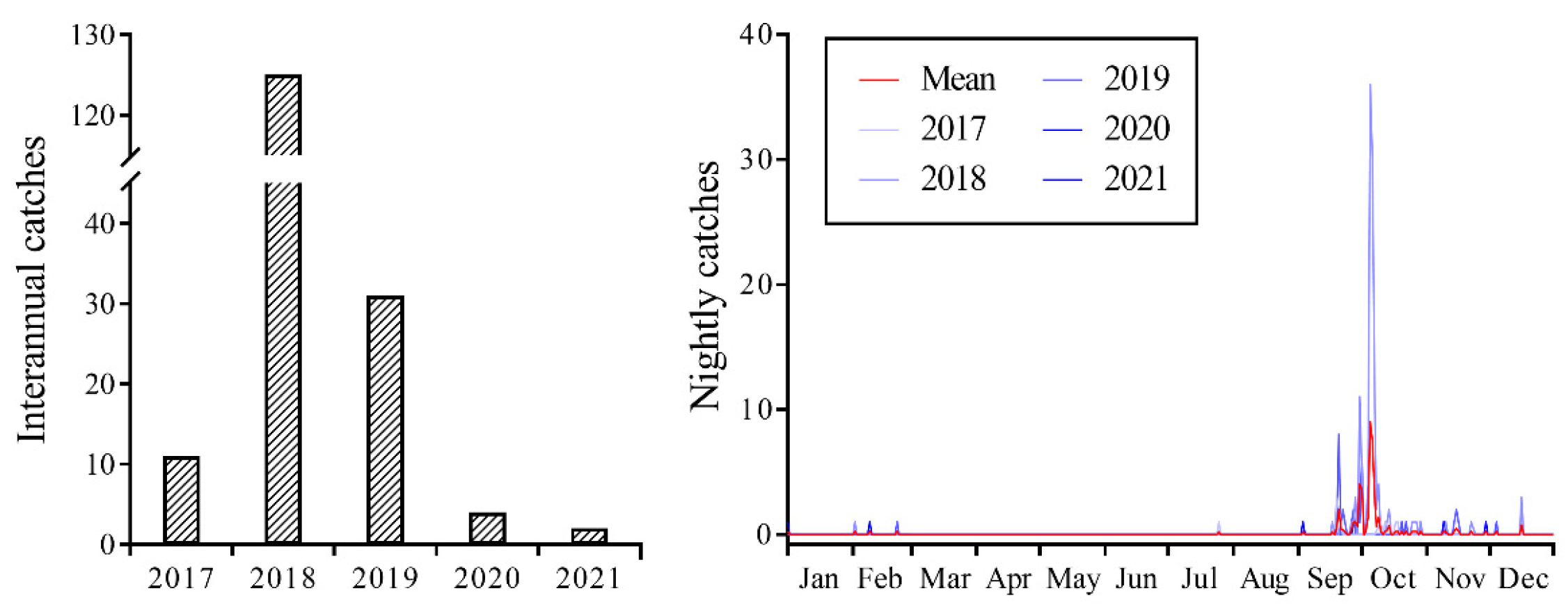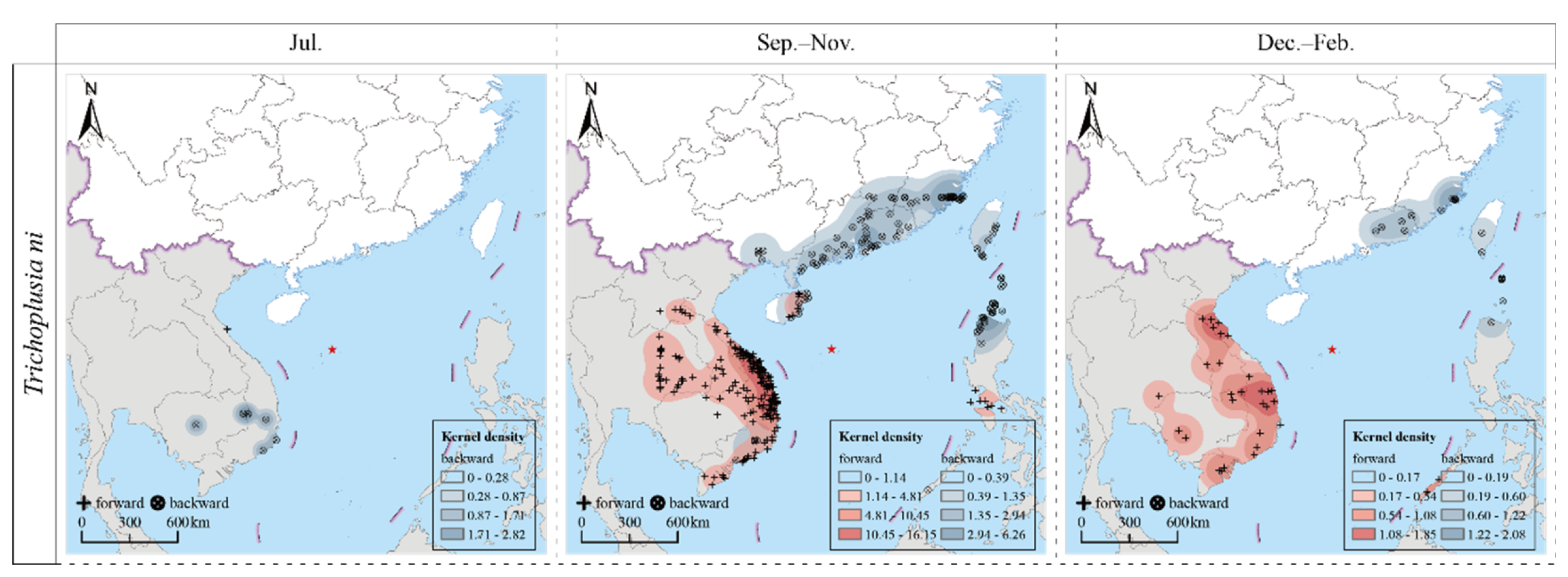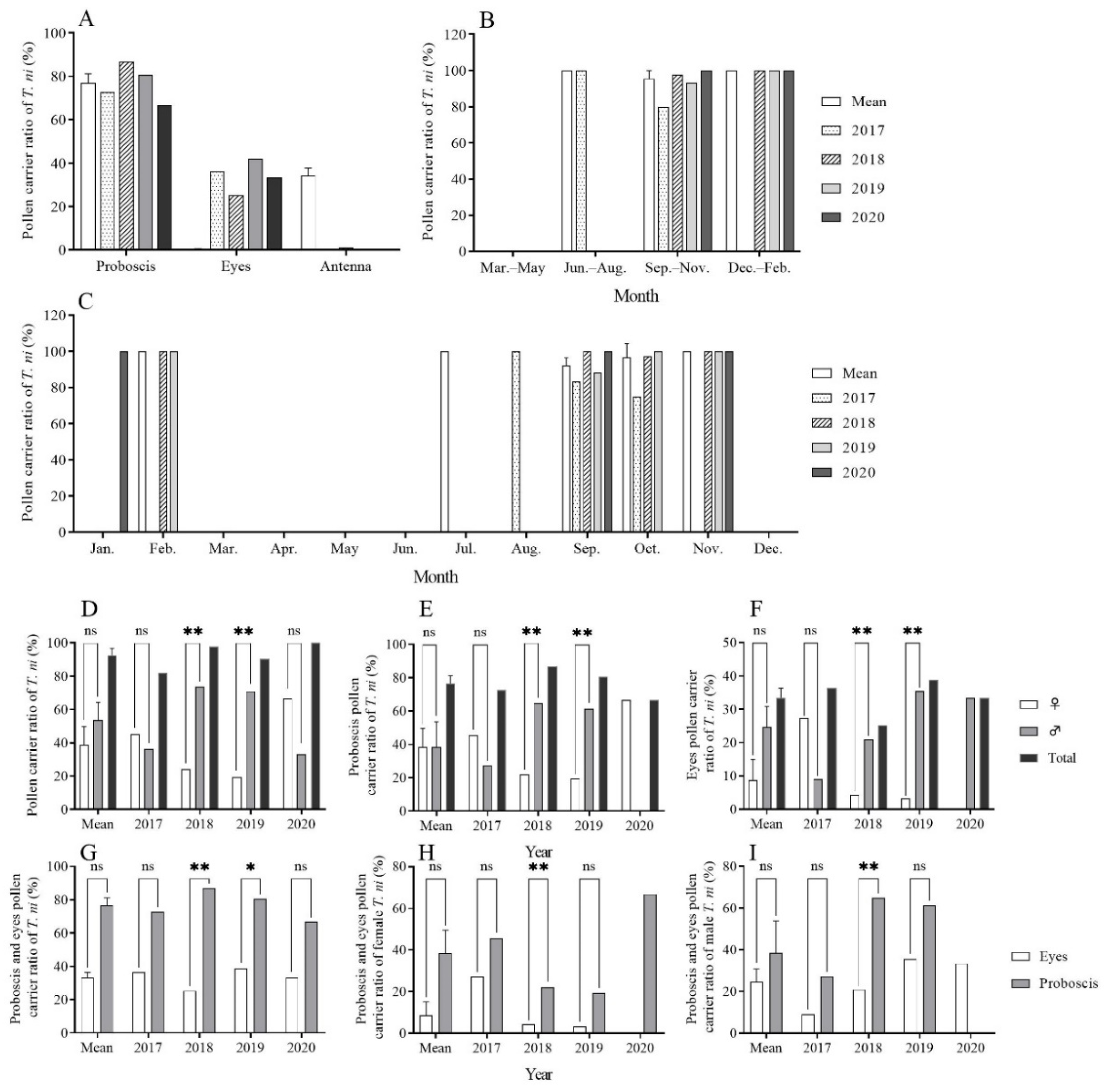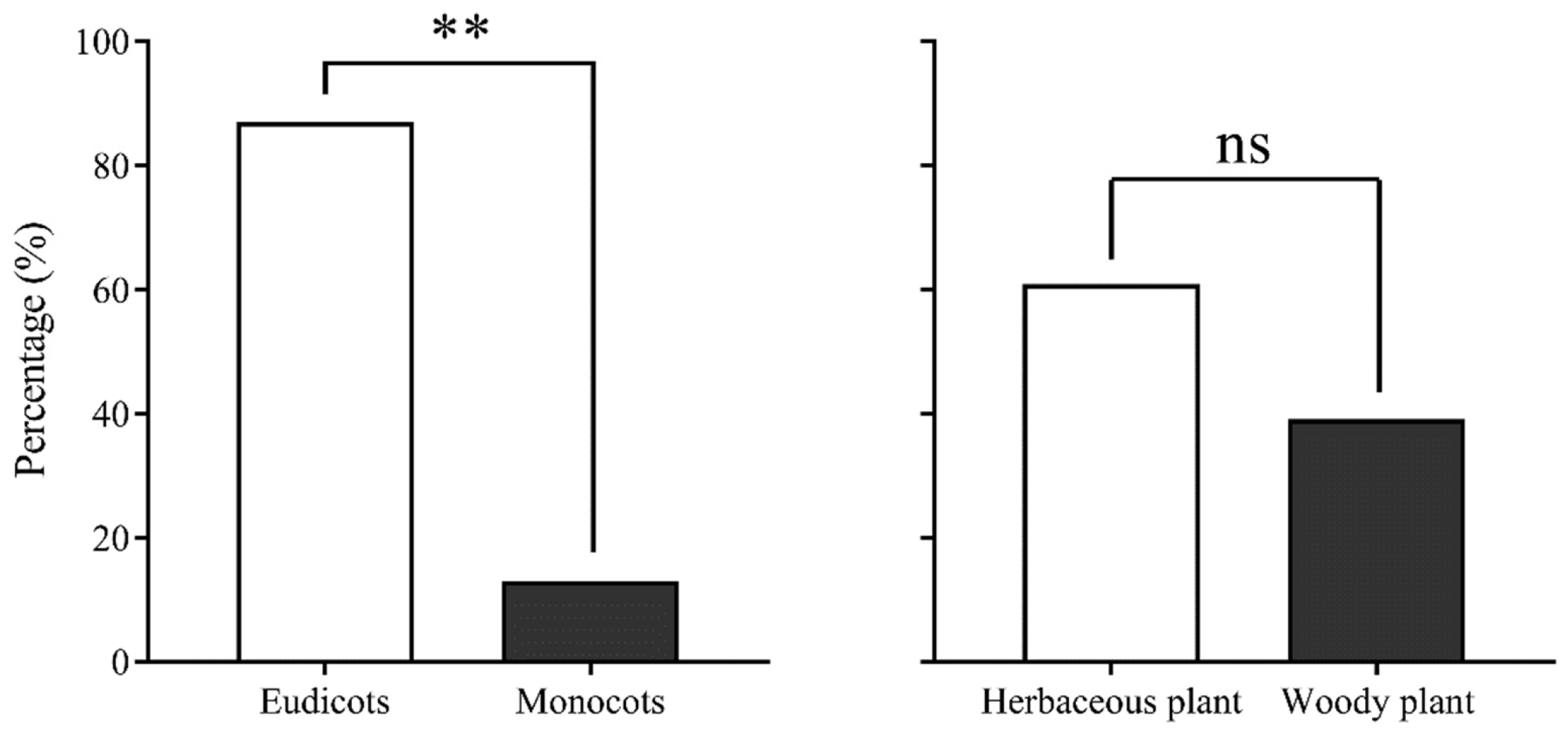Cross-Regional Pollination Behavior of Trichoplusia ni between China and the Indo-China Peninsula
Abstract
:1. Introduction
2. Results
2.1. Seasonal Population Dynamics of Migratory CL
2.2. Seasonal Pattern of Sex Ratio of Migratory CL
2.3. Migration Pattern of Migratory CL
2.4. Results for Surface Pollen Carried by Migratory CL
2.4.1. Pollen-Carrying Body Parts in Migratory CL
2.4.2. Seasonal Pollen-Carrying Rate of Migratory CL
2.4.3. Sex Differences in Pollen-Carrying Rates
2.4.4. Host Plants Inferred from Pollens Carried by Migratory CL
2.4.5. Characteristics of Host Plants Producing Pollen Carried by Migratory CL
3. Discussion
4. Materials and Methods
4.1. Study Site
4.2. Monitoring of Searchlight System
4.3. Trajectory Simulation
4.4. Detection of Pollen on the Body Surface
4.4.1. Microscopic Examination and Scanning Electron Microscopic Imaging
4.4.2. Molecular Analysis
4.4.3. Pollen and Host Plant Identification
4.5. Statistical Analysis
Author Contributions
Funding
Data Availability Statement
Acknowledgments
Conflicts of Interest
References
- Qin, J.D.; Wang, C.Z. The relation of interaction between insects and plants to evolution. Acta Entomol. Sin. 2001, 44, 360–365. [Google Scholar]
- Potts, S.G.; Biesmeijer, J.C.; Kremen, C.; Neumann, P.; Schweiger, O.; Kunin, W.E. Global pollinator declines: Trends, impacts and drivers. Trends Ecol. Evol. 2010, 25, 345–353. [Google Scholar] [CrossRef]
- Magallón, S.; Gómez-Acevedo, S.; Sánchez-Reyes, L.L.; Hernández-Hernández, T. A metacalibrated time-tree documents the early rise of flowering plant phylogenetic diversity. New Phytol. 2015, 207, 437–453. [Google Scholar] [CrossRef]
- Bernays, E.A.; Bright, K.L.; Gonzalez, N.; Angel, J. Dietary mixing in a generalist herbivore: Tests of two hypotheses. Ecology 1994, 75, 1997–2006. [Google Scholar] [CrossRef]
- Ollerton, J.; Winfree, R.; Tarrant, S. How many flowering plants are pollinated by animals? Oikos 2011, 120, 321–326. [Google Scholar] [CrossRef]
- Rader, R.; Cunningham, S.A.; Howlett, B.G.; Inouye, D.W. Non-bee insects as visitors and pollinators of crops: Biology, ecology, and management. Annu. Rev. Entomol. 2020, 65, 391–407. [Google Scholar] [CrossRef] [PubMed]
- Requier, F.; Pérez-Méndez, N.; Andersson, G.K.S.; Blareau, E.; Merle, I.; Garibaldi, L.A. Bee and non-bee pollinator importance for local food security. Trends Ecol. Evol. 2023, 38, 196–205. [Google Scholar] [CrossRef] [PubMed]
- Buxton, M.N.; Gaskett, A.C.; Lord, J.M.; Pattemore, D.E. A global review demonstrating the importance of nocturnal pollinators for crop plants. J. Appl. Ecol. 2022, 59, 2890–2901. [Google Scholar] [CrossRef]
- Qin, J.D. The physiological bases of host-plant specificity of phytophagous insects. Acta Entomol. Sin. 1980, 23, 106–122. [Google Scholar]
- Gassmann, A.J.; Reisig, D.D. Management of insect pests with Bt crops in the United States. Annu. Rev. Entomol. 2023, 68, 13–29. [Google Scholar] [CrossRef]
- Galimberti, A.; Mattia, F.D.; Bruni, I.; Scaccabarozzi, D.; Sandionigi, A.; Barbuto, M.; Casiraghi, M.; Labra, M. A DNA barcoding approach to characterize pollen collected by honeybees. PLoS ONE 2014, 9, e109363. [Google Scholar] [CrossRef] [PubMed]
- Scaccabarozzi, D.; Dixon, K.W.; Tomlinson, S.; Milne, L.; Bohman, B.; Phillips, R.D.; Cozzolino, S. Pronounced differences in visitation by potential pollinators to co-occurring species of Fabaceae in the Southwest Australian biodiversity hotspot. Bot. J. Linn. Soc. 2020, 194, 308–325. [Google Scholar] [CrossRef]
- Jia, H.R.; Liu, Y.Q.; Li, X.K.; Li, H.; Pan, Y.F.; Hu, C.X.; Zhou, X.Y.; Wyckhuys, K.A.G.; Wu, K.M. Windborne migration amplifies insect-mediated pollination services. eLife 2022, 11, e76230. [Google Scholar] [CrossRef]
- Liu, Y.Q.; Fu, X.W.; Mao, L.M.; Xing, Z.L.; Wu, K.M. Host plants identification for adult Agrotis ipsilon, a long-distance migratory insect. Int. J. Mol. Sci. 2016, 17, 851. [Google Scholar] [CrossRef] [PubMed]
- Xu, G.; Guo, Y.Y.; Wu, K.M. Analyses of pollens adhering to cotton bollworm moths (Lepidoptera: Noctuidae). Sci. Agric. Sin. 1999, 32, 63–68. [Google Scholar]
- Valentini, A.; Pompanon, F.; Taberlet, P. DNA barcoding for ecologists. Trends Ecol. Evol. 2009, 24, 110–117. [Google Scholar] [CrossRef]
- Nguyen, K.O.; Al-Rashid, S.; Miller, M.C.; Diggs, J.T.; Lampert, E.C. Trichoplusia ni (Lepidoptera: Noctuidae) qualitative and quantitative sequestration of host plant carotenoids. Environ. Entomol. 2019, 48, 540–545. [Google Scholar] [CrossRef]
- Franklin, M.T.; Ritland, C.E.; Myers, J.H. Genetic analysis of cabbage loopers, Trichoplusia ni (Lepidoptera: Noctuidae), a seasonal migrant in western Northern America. Evol. Appl. 2011, 4, 89–99. [Google Scholar] [CrossRef]
- Lingren, P.D.; Bryant, V.M.; Raulston, J.R.; Pendleton, M.; Westbrook, J.; Jones, G.D. Adult feeding host range and migratory activities of corn earworm, cabbage looper and celery looper (Lepidoptera: Noctuidae) moths as evidenced by attached pollen. J. Econ. Entomol. 1993, 86, 1429–1439. [Google Scholar] [CrossRef]
- Zhou, X.Y.; Wu, Q.L.; Jia, H.R.; Wu, K.M. Searchlight trapping reveals seasonal cross-ocean migration of fall armyworm over the South China Sea. J. Integr. Agric. 2021, 20, 673–684. [Google Scholar] [CrossRef]
- Chapman, J.W.; Nesbit, R.L.; Burgin, L.E.; Reynolds, D.R.; Smith, A.D.; Middleton, D.R.; Hill, J.K. Flight orientation behaviors promote optimal migration trajectories in high-flying insects. Science 2010, 327, 682–685. [Google Scholar] [CrossRef] [PubMed]
- Fu, X.W.; Feng, H.Q.; Liu, Z.F.; Wu, K.M. Trans-regional migration of the beet armyworm, Spodoptera exigua (Lepidoptera: Noctuidae), in North-East Asia. PLoS ONE 2017, 12, e0183582. [Google Scholar] [CrossRef] [PubMed]
- Chapman, J.W.; Bell, J.R.; Burgin, L.E.; Reynolds, D.R.; Smith, A.D.; Pittersson, L.B.; Hill, J.K.; Bonsall, M.B.; Thomas, J.A. Seasonal migration to high latitudes results in major reproductive benefits in an insect. Proc. Natl. Acad. Sci. USA 2012, 109, 14924–14929. [Google Scholar] [CrossRef] [PubMed]
- Westbrook, J.K.; Nagoshi, R.N.; Meagher, R.L.; Fleischer, S.J.; Jairam, S. Modeling seasonal migration of fall armyworm moths. Int. J. Biometeorol. 2016, 60, 255–267. [Google Scholar] [CrossRef]
- Li, X.J.; Wu, M.F.; Ma, J.; Gao, B.Y.; Wu, Q.L.; Chen, A.D.; Liu, J.; Jiang, Y.Y.; Zhai, B.P.; Early, R.; et al. Prediction of migratory routes of the invasive fall armyworm in eastern China using a trajectory analytical approach. Pest Manag. Sci. 2020, 76, 454–463. [Google Scholar] [CrossRef] [PubMed]
- Jones, C.M.; Parry, H.; Tay, W.T.; Reynolds, D.R.; Chapman, J.W. Movement ecology of pest Helicoverpa: Implications for ongoing spread. Annu. Rev. Entomol. 2019, 64, 277–295. [Google Scholar] [CrossRef]
- Zhang, Z.T. Insect migration and insect migration arena. Plant Prot. 1992, 18, 48–50. [Google Scholar]
- Wotton, K.R.; Gao, B.Y.; Menz, M.H.M.; Morris, R.K.A.; Ball, S.G.; Lim, K.S.; Reynolds, D.R.; Hu, G.; Chapman, J.W. Mass seasonal migrations of hoverflies provide extensive pollination and crop protection services. Curr. Biol. 2019, 29, 2167–2173. [Google Scholar] [CrossRef]
- Wratten, S.D.; Bowie, M.H.; Hickman, J.M.; Evans, A.M.; Sedcole, J.R.S.; Tylianakis, J.M. Field boundaries as barriers to movement of hover flies (Diptera: Syrphidae) in cultivated land. Oecologia 2003, 134, 605–611. [Google Scholar] [CrossRef] [PubMed]
- Hendrix, W.H., III. Migrational and Behavioral Studies of Two Adult Noctuid (Lepidoptera: Noctuidae) Species Plus Feeding Observations of Some Moths Common to Iowa. Ph. D. Thesis, Lowa State University, Ames, IA, USA, 1990. [Google Scholar]
- Bryant, V.M.; Pendleton, M.; Murry, R.E.; Lingren, P.D.; Raulston, J.R. Techniques for studying pollen adhering to nectar-feeding corn earworm (Lepidoptera: Noctuidae) moths using scanning electron microscopy. J. Econ. Entomol. 1991, 84, 237–240. [Google Scholar] [CrossRef]
- Singer, R.; Cocucci, A.A. Eye attached hemipollinaria in the hawkmoth and settling moth pollination of Habenaria (Orchidaceae): A study on functional morphology in 5 species from subtropical south America. Bot. Acta 1997, 110, 328–337. [Google Scholar] [CrossRef]
- Singer, R.B. Pollination biology of Habenaria parviflora (Orchidaceae: Habenariinae) in southeastern Brazil. Darwiniana 2001, 39, 201–207. [Google Scholar]
- Singer, R.B. The pollination biology of Sauroglossum elatum Lindl. (Orchidaceae: Spiranthinae): Moth-pollination and protandry in neotropical Spiranthinae. Bot. J. Linn. Soc. 2002, 138, 9–16. [Google Scholar] [CrossRef]
- Courtney, S.P.; Hill, C.J.; Westerman, A. Pollen carried for long distances by butterflies. Oikos 1982, 38, 260–263. [Google Scholar] [CrossRef]
- Wu, K.M.; Guo, Y.Y. The evolution of cotton pest management practices in China. Annu. Rev. Entomol. 2005, 50, 31–52. [Google Scholar] [CrossRef]
- Isman, M.B. Botanical insecticides, deterrents, and repellents in modern agriculture and an increasingly regulated world. Annu. Rev. Entomol. 2006, 51, 45–66. [Google Scholar] [CrossRef]
- Tabashnik, B.E.; Huang, F.N.; Ghimire, M.N.; Leonard, B.R.; Siegfried, B.D.; Rangasamy, M.; Yang, Y.J.; Wu, Y.D.; Gahan, L.J.; Heckel, D.G.; et al. Efficacy of genetically modified Bt toxins against insects with different genetic mechanisms of resistance. Nat. Biotechnol. 2011, 29, 1128–1131. [Google Scholar] [CrossRef]
- MacGregor, C.J.; Pocock, M.J.O.; Fox, R.; Evans, D.M. Pollination by nocturnal Lepidoptera, and the effects of light pollution: A review. Ecol. Entomol. 2015, 40, 187–198. [Google Scholar] [CrossRef] [PubMed]
- Riley, J.R.; Reynolds, D.R.; Smith, A.D.; Edwards, A.S.; Zhang, X.X.; Cheng, X.N.; Wang, H.K.; Cheng, J.Y.; Zhai, B.P. Observations of the autumn migration of the rice leaf roller Cnaphalocrocis medinalis (Lepidoptera: Pyralidae) and other moths in eastern China. Bull. Entomol. Res. 1995, 85, 397–414. [Google Scholar] [CrossRef]
- Gatehouse, A.G. Behavior and ecological genetics of wind-borne migration by insects. Annu. Rev. Entomol. 1997, 42, 475–502. [Google Scholar] [CrossRef]
- Taylor, L.R.; Brown, E.S.; Littlewood, S.C. The effect of size on the height of flight of migrant moths. Bull. Entomol. Res. 1979, 69, 605–609. [Google Scholar] [CrossRef]
- Chapman, J.W.; Reynolds, D.R.; Wilson, K. Long-range seasonal migration in insects: Mechanisms, evolutionary drivers and ecological consequences. Ecol. Lett. 2015, 18, 287–302. [Google Scholar] [CrossRef] [PubMed]
- Zhang, Y.H.; Chen, L.; Cheng, D.F.; Zhang, Y.J.; Jiang, Y.Y.; Jiang, J.W. Radar observation and population analysis on the migration of the clover cutworm, Scotogramma trifolii Rottemberg (Lepidoptera: Pyralidae). Acta Entomol. Sin. 2007, 50, 494–500. [Google Scholar]
- Chapman, J.W.; Reynolds, D.R.; Hill, J.K.; Sivell, D.; Smith, A.D.; Woiwod, I.P. A seasonal switch in compass orientation in a high-flying migrant moth. Curr. Biol. 2008, 18, R908–R909. [Google Scholar] [CrossRef] [PubMed]
- Ma, J.; Wang, Y.P.; Wu, M.F.; Gao, B.Y.; Liu, J.; Lee, G.S.; Otuka, A.; Hu, G. High risk of the fall armyworm invading Japan and Korean Peninsula via overseas migration. J. Appl. Entomol. 2019, 143, 911–920. [Google Scholar] [CrossRef]
- Chen, P.H.; Pan, Y.B.; Chen, R.K. High-throughput procedure for single pollen grain collection and polymerase chain reaction in plants. J. Integr. Plant Biol. 2008, 50, 375–383. [Google Scholar] [CrossRef]
- Cheng, T.; Xu, C.; Lei, L.; Zhang, Y.; Zhou, S.L. Barcoding the kingdom Plantae: New PCR primers for ITS regions of plants with improved universality and specificity. Mol. Ecol. Resour. 2016, 16, 138–149. [Google Scholar] [CrossRef] [PubMed]
- Hawkins, J.; de Vere, N.; Griffith, A.; Ford, C.R.; Allainguilaume, J.; Hegarty, M.J.; Baillie, L.; Adams-Groom, B. Using DNA metabarcoding to identify the floral composition of honey: A new tool for investigating honey bee foraging preferences. PLoS ONE 2015, 10, e0134735. [Google Scholar] [CrossRef]
- Ma, D.W.; Zhang, C.H.; Gao, S.Z.; Ma, N.; Liu, H.H.; Zhang, Y.P.; Sun, L. Pollen Flora of China Vegetables by SEM; China Agriculture Press: Beijing, China, 1999. [Google Scholar]
- Li, T.Q.; Cao, H.J.; Kang, M.S.; Zhang, Z.X.; Zhao, N.; Zhang, H. Pollen Flora of China, Woody Plants by SEM; Science Press: Beijing, China, 2010. [Google Scholar]
- Chaves, L.F. An entomologist guide to demystify pseudoreplication: Data analysis of field studies with design constraints. J. Med. Entomol. 2010, 47, 291–298. [Google Scholar] [CrossRef]
- Li, C.H.; Sun, Z.H.; Chen, G.; Hu, Y. Knernel density estimation and its application to clustering algorithm construction. J. Comput. Res. Dev. 2004, 41, 1712–1719. [Google Scholar]
- Okabe, A.; Satoh, T.; Sugihara, K. A kernel density estimation method for networks, its computational method and a GIS-based tool. Int. J. Geogr. Inf. Sci. 2009, 23, 7–32. [Google Scholar] [CrossRef]
- Aditian, A.; Kubota, T.; Shinohara, Y. Comparison of GIS-based landslide susceptibility models using frequency ratio, logistic regression, and artificial neural network in a tertiary region of Ambon, Indonesia. Geomorphology 2018, 318, 101–111. [Google Scholar] [CrossRef]





| Year | Pollen-Carrying Body Parts | χ2 | df | p |
|---|---|---|---|---|
| 2017 | Proboscis vs. Compound eyes | 1.333 | 1 | 0.388 |
| 2018 | Proboscis vs. Compound eyes | 30.745 | 1 | <0.001 |
| Proboscis vs. Antennae | 76.050 | 1 | <0.001 | |
| Compound eyes vs. Antennae | 20.167 | 1 | <0.001 | |
| 2019 | Proboscis vs. Compound eyes | 3.789 | 1 | 0.073 |
| 2020 | Proboscis vs. Compound eyes | 0.333 | 1 | 1.000 |
| No. | Identification | Trapped Periods | Class | Stem | Flowering Periods |
|---|---|---|---|---|---|
| 1 | Aster tataricus | February, September–November | Eudicots | Herb | July–September |
| 2 | Tripolium pannonicum | September | Eudicots | Herb | June–December |
| 3 | Alisma L. | October | Monocots | Herb | May–October |
| 4 | Chrysanthemum zawadskii | October | Eudicots | Herb | June–November |
| 5 | Festuca L. | September | Monocots | Herb | June–September |
| 6 | Melia azedarach | October | Eudicots | Xylophyta | April, May |
| 7 | Heliotropium L. | September–October | Eudicots | Herb | February–October |
| 8 | Ligustrum L. | October | Eudicots | Xylophyta | April–August |
| 9 | Brassica carinata/B. juncea/B. nigra | October | Eudicots | Herb | April, May |
| 10 | Impatiens balsamina/I. walleriana | September | Eudicots | Herb | July–October |
| 11 | Bougainvillea spectabilis | September–October | Eudicots | Xylophyta | June–December |
| 12 | Rubia cordifolia | October | Eudicots | Herb | July–September |
| 13 | Violaceae | September | Eudicots | Xylophyta | - |
| 14 | Amorpha fruticosa | October | Eudicots | Xylophyta | May, June |
| 15 | Rinorea bengalensis | October | Eudicots | Xylophyta | March–August |
| 16 | Asparagus L. | October | Monocots | Herb | May–August |
| 17 | Eucalyptus L’Hér. | October | Eudicots | Xylophyta | March, April |
| 18 | Humulus japonicus | October | Eudicots | Herb | July–September |
| 19 | Helianthus annuus, Rubia cordifolia and Phaseolus L. | February | Eudicots | Herb | June–September |
| 20 | Bidens alba | February, September | Eudicots | Herb | August, September |
| 21 | Helianthus annuus and Unknown | September–October | Eudicots | Herb | July–September |
| 22 | Platanus × acerifolia | October | Eudicots | Xylophyta | April–May |
| 23 | Scaevola taccada | September–October | Eudicots | Xylophyta | April–December |
| 24–30 | Unknown | September–October |
| Item | Domain 1 |
|---|---|
| Location | 16°50.1′ N, 112°19.8′ E |
| Number of grid points | 200 × 200 |
| Distance between grid points | 10 |
| Layers | 32 |
| Map projection | Lambert |
| Microphysics scheme | Thompson |
| Longwave radiation scheme | RRTMG |
| Shortwave radiation scheme | RRTMG |
| Surface layer scheme | Monin–Obukhov |
| Land surface scheme | Noah |
| Planetary boundary layer scheme | Mellor–Yanmada–Janjic |
| Cumulus parameterization | Tiedtke |
| Simulated time | Every 36 h |
Disclaimer/Publisher’s Note: The statements, opinions and data contained in all publications are solely those of the individual author(s) and contributor(s) and not of MDPI and/or the editor(s). MDPI and/or the editor(s) disclaim responsibility for any injury to people or property resulting from any ideas, methods, instructions or products referred to in the content. |
© 2023 by the authors. Licensee MDPI, Basel, Switzerland. This article is an open access article distributed under the terms and conditions of the Creative Commons Attribution (CC BY) license (https://creativecommons.org/licenses/by/4.0/).
Share and Cite
Zhou, X.; Jia, H.; Zhang, H.; Wu, K. Cross-Regional Pollination Behavior of Trichoplusia ni between China and the Indo-China Peninsula. Plants 2023, 12, 3778. https://doi.org/10.3390/plants12213778
Zhou X, Jia H, Zhang H, Wu K. Cross-Regional Pollination Behavior of Trichoplusia ni between China and the Indo-China Peninsula. Plants. 2023; 12(21):3778. https://doi.org/10.3390/plants12213778
Chicago/Turabian StyleZhou, Xianyong, Huiru Jia, Haowen Zhang, and Kongming Wu. 2023. "Cross-Regional Pollination Behavior of Trichoplusia ni between China and the Indo-China Peninsula" Plants 12, no. 21: 3778. https://doi.org/10.3390/plants12213778
APA StyleZhou, X., Jia, H., Zhang, H., & Wu, K. (2023). Cross-Regional Pollination Behavior of Trichoplusia ni between China and the Indo-China Peninsula. Plants, 12(21), 3778. https://doi.org/10.3390/plants12213778






